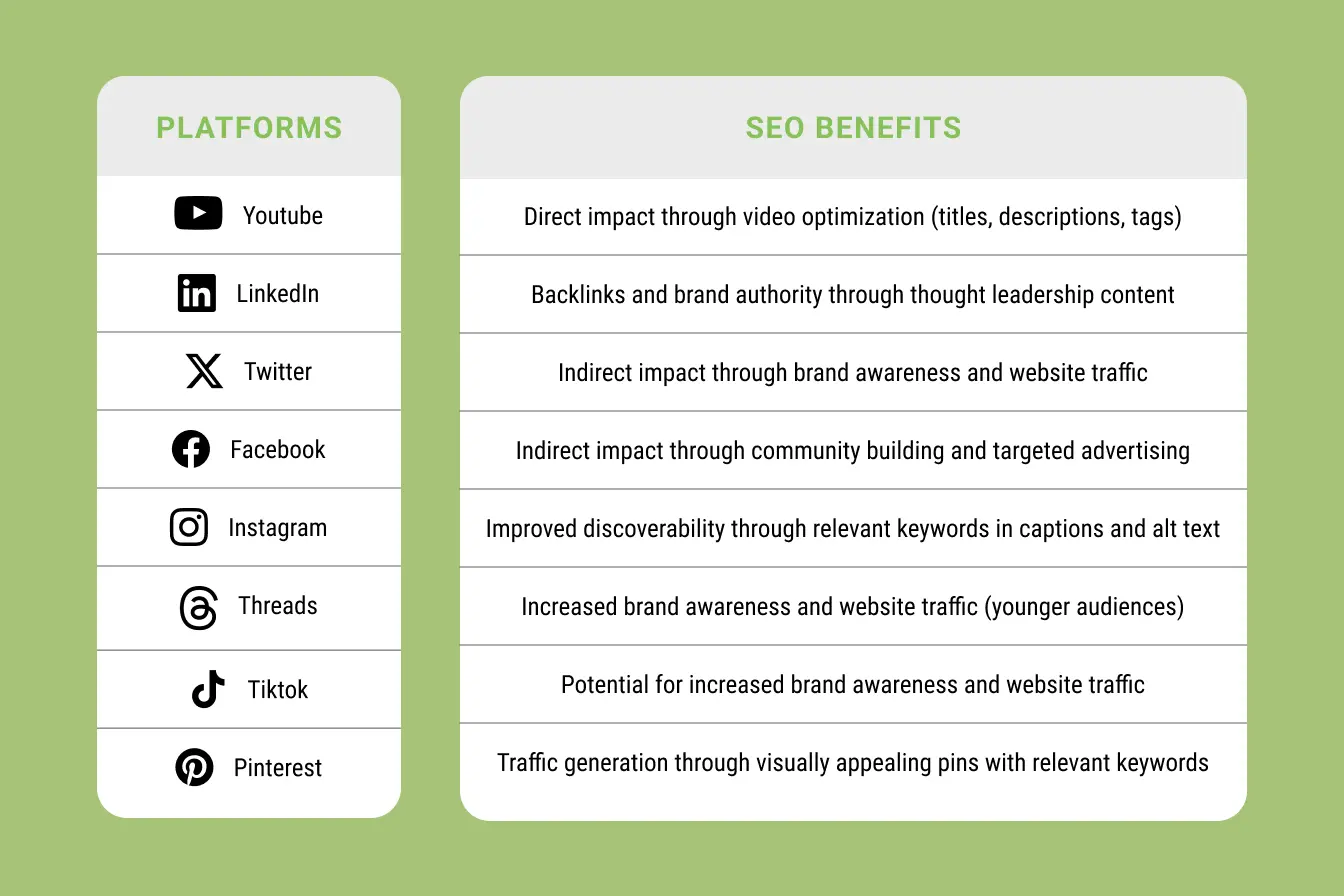
Social media is not just a platform for social interaction; it has evolved into a powerful marketing tool that businesses cannot afford to ignore. With billions of active users across various social media platforms like Facebook, Instagram, YouTube, and LinkedIn, these networks offer unparalleled opportunities for brands to connect with their audience, build their online presence, and drive traffic to their websites. Indeed, 89% of marketers report that social media has increased their brand’s visibility.
However, leveraging social media for marketing success requires more than just posting content; it demands a well-thought-out strategy that aligns with your SEO goals. This article delves into how effective social media posting can enhance your online marketing efforts, improve your SEO performance, and ultimately boost your brand’s visibility and engagement.
Which Social Media Platforms Are the Best for SEO?
Different social media platforms cater to various audiences and have unique features that can enhance your SEO strategy. Understanding the strengths and demographics of each platform can help you tailor your content to maximize its impact. Here’s a closer look at some of the best social media platforms for SEO and their specific advantages:

1. YouTube
Audience: YouTube is the second largest search engine after Google, with over 2 billion logged-in users monthly. It appeals to all age groups, making it a versatile platform.
Advantages: Video content is highly engaging and can significantly boost your SEO. By optimizing video titles, descriptions, and tags with relevant keywords, you can improve your visibility on both YouTube and Google. Creating high-quality, informative videos can drive substantial traffic to your website, increasing dwell time and enhancing
2. LinkedIn
Audience: LinkedIn is the go-to platform for professionals and businesses, particularly in the B2B sector.
Advantages: LinkedIn is ideal for building professional connections, sharing industry insights, and establishing brand authority. It’s an excellent platform for B2B marketing, helping businesses reach decision-makers and industry leaders. Regularly posting valuable content on LinkedIn can drive traffic to your website and improve your SEO.
3. Twitter
Audience: Known for real-time updates, Twitter attracts a diverse range of age groups and is effective for sharing news and updates.
Advantages: Twitter is effective for sharing real-time updates, news, and engaging in conversations. The use of hashtags and trending topics can enhance the discoverability of your content. Regular interactions on Twitter can increase brand awareness and drive traffic to your website.
4. Facebook
Audience: Facebook boasts over 2.8 billion active users worldwide, making it a diverse platform that appeals to various age groups. It’s suitable for almost any type of business due to its extensive reach.
Advantages: Facebook supports multiple content formats, including text, images, videos, and live streams. This versatility allows businesses to present their brand in different ways. Facebook’s powerful ad targeting options enable you to reach specific demographics effectively. Engaging content on Facebook can lead to increased shares and interactions, signaling search engines about your content’s relevance and authority.
5. Instagram
Audience: Instagram is particularly popular among younger demographics, especially those aged 18-34. It’s a visually-driven platform, ideal for brands in fashion, beauty, lifestyle, and food industries.
Advantages: Instagram’s focus on high-quality visuals can significantly enhance your brand’s aesthetic appeal. Features like Stories, IGTV, and Reels provide creative ways to showcase products and services. The use of hashtags can increase the visibility of your posts, and Instagram’s shopping features facilitate direct purchases, driving traffic to your website.
6. Threads
Audience: Threads attracts users interested in in-depth discussions and community building.
Advantages: This text-based conversation platform is excellent for brands looking to establish thought leadership and engage in meaningful dialogues. It allows for sharing detailed content and insights, which can position your brand as an industry expert. Engaging in conversations and responding to user queries can improve your brand’s reputation and credibility.
7. TikTok
Audience: TikTok is extremely popular among Gen Z and is known for its short-form videos.
Advantages: TikTok’s highly engaging and viral nature makes it perfect for brand storytelling and reaching a younger audience. Creative and entertaining content on TikTok can drive immense traffic to your website and increase brand recognition. Additionally, using trending hashtags and participating in challenges can boost your content’s discoverability.
8. Pinterest
Audience: Pinterest serves as a visual discovery engine and is popular in industries like fashion, food, and home decor.
Advantages: Pinterest is great for driving significant traffic through pinboards. Each pin can link back to your website, providing valuable backlinks. Optimizing your pins with relevant keywords and high-quality images can boost your visibility both on Pinterest and search engines.
Why Social Media Strategy Improves Your SEO Performance

A well-executed social media strategy can significantly enhance your SEO performance. Here are several ways in which social media impacts SEO:
1. Increased Brand Visibility
Active social media profiles enhance your brand’s visibility. When users engage with your content through likes, shares, and comments, it signals to search engines that your brand is relevant and authoritative. This increased visibility can lead to higher search engine rankings. Social media profiles often rank highly in search results, providing another avenue for potential customers to discover your brand.
2. Quality Backlinks
Social media platforms can be a source of high-quality backlinks. When your content is shared on social media and picked up by other websites, it can generate backlinks to your site. Backlinks are a key factor in SEO, as they signal to search engines that your content is valuable and trustworthy. The more high-quality backlinks you have, the better your chances of ranking higher in search engine results pages (SERPs).
3. Content Distribution
Social media is a powerful channel for distributing your content. By sharing blog posts, videos, infographics, and other content on social media, you drive traffic to your website. Increased website traffic can positively impact your SEO by improving metrics such as dwell time and reducing bounce rates. When visitors spend more time on your site, it signals to search engines that your content is engaging and relevant.
4. User Engagement
Engaging with your audience on social media can boost your social signals, which indirectly impact your SEO. High levels of engagement indicate valuable content, encouraging search engines to rank your site higher. Responding to comments, messages, and mentions promptly helps build a community around your brand, fostering loyalty and trust. High engagement rates on social media can also lead to more shares and backlinks, further enhancing your SEO.
5. Local SEO
For businesses with a physical presence, social media profiles can improve local SEO. Consistent NAP (Name, Address, Phone Number) information across social media profiles and local directories enhances your local search visibility. Engaging with local events and communities on social media can also boost your local SEO efforts. Additionally, reviews and check-ins on platforms like Facebook can increase your credibility and visibility in local search results.
6. Increased Indexing
Social media posts can be indexed by search engines, making your content discoverable through search. While not all social media content is indexed, having a consistent and active presence increases the chances that your posts will be picked up by search engines. This additional indexing can help drive more traffic to your website and improve your overall search visibility.
7. Social Sharing

Social sharing amplifies your content’s reach, exposing it to a wider audience. When users share your content on their social media profiles, it increases the potential for more people to see and engage with it. This increased exposure can lead to more website visits, backlinks, and social signals, all of which contribute to better SEO performance.
8. Brand Authority
Consistent and valuable content on social media helps establish your brand as an authority in your industry. When users recognize your brand as a trusted source of information, they are more likely to visit your website and share your content. Building brand authority through social media can lead to increased organic traffic and higher search rankings.
9. Enhanced Customer Insights
Social media provides valuable insights into your audience’s preferences and behaviors. By analyzing engagement metrics and feedback, you can better understand what content resonates with your audience. This knowledge allows you to create more targeted and relevant content, improving your chances of ranking higher in search results.
10. Competitive Advantage
A strong social media strategy can give you a competitive edge in your industry. Staying active on social media and consistently producing high-quality content sets you apart from competitors who may not be leveraging these platforms effectively. This competitive advantage can lead to higher search rankings and increased brand visibility.
Social Media Posting Tips for Online Marketing
To maximize the benefits of social media for online marketing, it’s essential to develop a strategic approach to posting. Here are some key tips to help you optimize your social media efforts and enhance your online presence:

1. Consistency is Key
Post Regularly: Maintaining a regular posting schedule keeps your audience engaged and ensures that your content stays fresh in their minds. Consistency helps build a loyal following and increases the chances of your content being shared. Create a content calendar to plan and schedule your posts in advance, ensuring you maintain a steady flow of content.
Balanced Posting Frequency: While it’s important to post regularly, avoid overwhelming your audience with too many posts. Find a balance that keeps your audience engaged without saturating their feeds. Analyze your engagement metrics to determine the optimal posting frequency for your brand.
2. Quality Over Quantity
High-Quality Content: Focus on creating high-quality, valuable content that resonates with your audience. Content that is informative, entertaining, or inspiring is more likely to be shared and linked to, which can boost your SEO. Invest time in crafting well-researched articles, eye-catching visuals, and engaging videos.
Diverse Content Formats: Use a mix of text, images, videos, and interactive content to keep your audience engaged. Different formats cater to different preferences and can increase the likelihood of your content being shared. For instance, infographics can simplify complex information, while videos can provide in-depth explanations.
3. Engage with Your Audience
Prompt Responses: Respond to comments, messages, and mentions promptly. Engaging with your audience builds a community around your brand, fosters loyalty, and increases engagement. High engagement rates can improve your visibility on social media and indirectly impact your SEO.
Interactive Content: Encourage interaction by asking questions, running polls, and hosting live sessions. Interactive content not only engages your audience but also provides valuable insights into their preferences and opinions. This feedback can guide your future content creation efforts.
4. Use Visuals Effectively
Professional Design: Visual content is more engaging and shareable. Invest in professional design services, such as those offered by Align Agency, to create eye-catching social media posts. High-quality visuals can capture attention and enhance your brand’s image.
Consistent Branding: Maintain consistent branding across your visuals, including logos, color schemes, and typography. Consistency reinforces your brand identity and makes your content easily recognizable. Use tools like Canva or Adobe Spark to create branded templates for your posts.
5. Leverage Hashtags and Keywords
Relevant Hashtags: Use relevant hashtags to increase the discoverability of your posts. Research trending hashtags in your niche and incorporate them strategically. Hashtags can help your content reach a broader audience and improve your visibility on social media platforms.
SEO Keywords: Incorporate SEO keywords into your social media profiles and posts. Using keywords that align with your content and audience’s search intent can improve your search rankings. Optimize your bio, captions, and hashtags with relevant keywords to enhance discoverability.
6. Analyze and Adjust
Monitor Performance: Use analytics tools to track the performance of your social media campaigns. Monitor metrics such as engagement, reach, and website traffic to understand what works and adjust your strategy accordingly. Regular analysis helps optimize your social media efforts for better results.
A/B Testing: Experiment with different types of content, posting times, and hashtags to see what resonates best with your audience. A/B testing allows you to compare the performance of different posts and refine your strategy based on data-driven insights.
7. Collaborate with Influencers
Influencer Partnerships: Collaborate with influencers in your industry to reach a broader audience. Influencers have established credibility and can help promote your brand authentically. Choose influencers whose values align with your brand and whose followers match your target audience.
User-Generated Content: Encourage your audience to create and share content featuring your products or services. User-generated content builds trust and authenticity, as it comes from real customers. Share this content on your social media profiles to showcase customer satisfaction and enhance engagement.
8. Utilize Social Media Tools
Scheduling Tools: Use scheduling tools like Hootsuite, Buffer, or Sprout Social to plan and automate your posts. These tools can help you maintain consistency, save time, and ensure your content is posted at optimal times for maximum engagement.
Content Creation Tools: Utilize content creation tools like Canva, Adobe Spark, and Lumen5 to produce high-quality visuals and videos. These tools offer templates, design elements, and editing features that can enhance the quality and appeal of your social media content.
Conclusion
Incorporating a strategic social media posting approach into your online marketing efforts can significantly enhance your SEO performance. By understanding the strengths of different social media platforms, creating engaging content, and leveraging professional design services, you can build a strong online presence that drives traffic, engagement, and conversions. Start optimizing your social media strategy today and watch your online marketing efforts soar.







